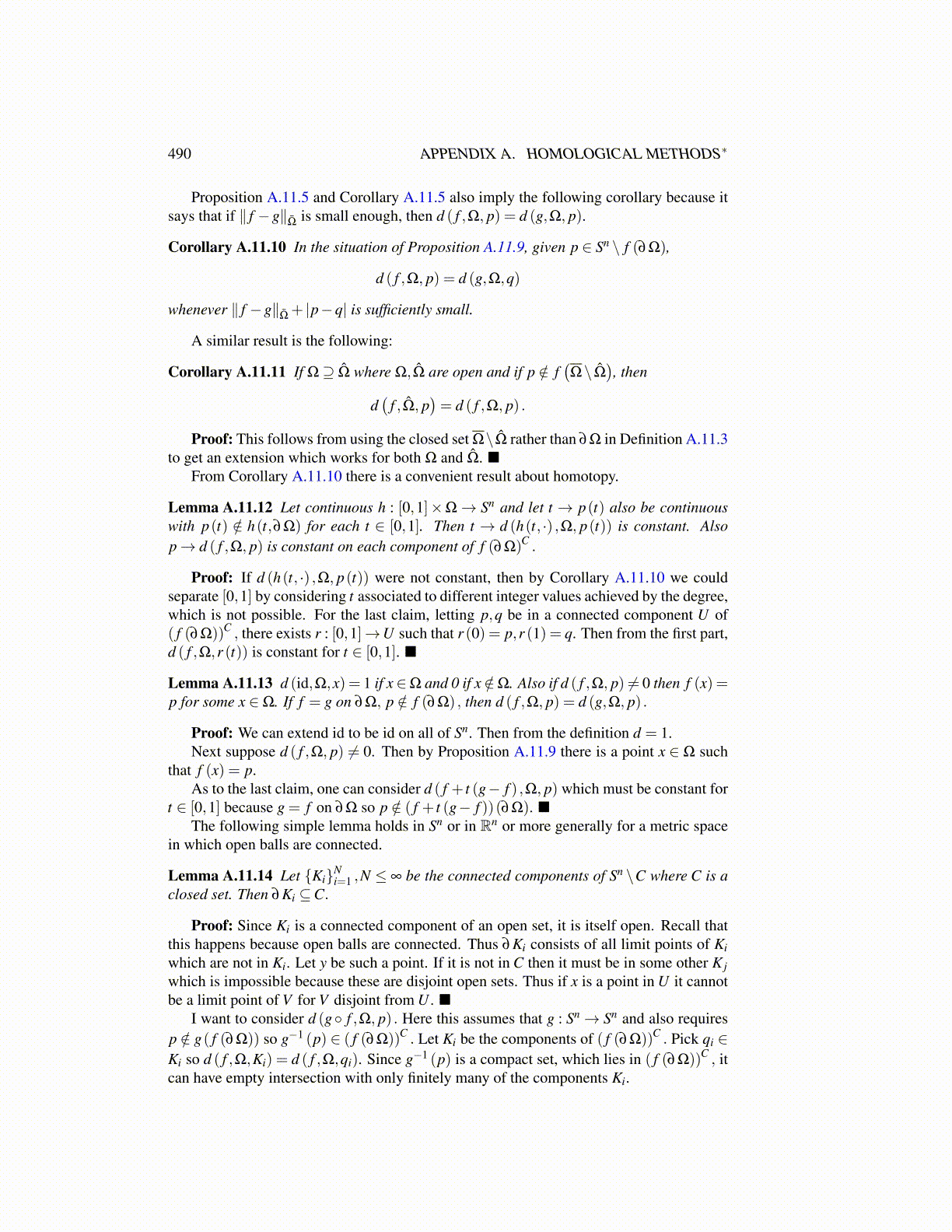
490 APPENDIX A. HOMOLOGICAL METHODS∗
Proposition A.11.5 and Corollary A.11.5 also imply the following corollary because itsays that if ∥ f −g∥
Ω̄is small enough, then d ( f ,Ω, p) = d (g,Ω, p).
Corollary A.11.10 In the situation of Proposition A.11.9, given p ∈ Sn \ f (∂Ω),
d ( f ,Ω, p) = d (g,Ω,q)
whenever ∥ f −g∥Ω̄+ |p−q| is sufficiently small.
A similar result is the following:
Corollary A.11.11 If Ω⊇ Ω̂ where Ω,Ω̂ are open and if p /∈ f(Ω\ Ω̂
), then
d(
f ,Ω̂, p)= d ( f ,Ω, p) .
Proof: This follows from using the closed set Ω\Ω̂ rather than ∂Ω in Definition A.11.3to get an extension which works for both Ω and Ω̂. ■
From Corollary A.11.10 there is a convenient result about homotopy.
Lemma A.11.12 Let continuous h : [0,1]×Ω→ Sn and let t → p(t) also be continuouswith p(t) /∈ h(t,∂Ω) for each t ∈ [0,1]. Then t → d (h(t, ·) ,Ω, p(t)) is constant. Alsop→ d ( f ,Ω, p) is constant on each component of f (∂Ω)C .
Proof: If d (h(t, ·) ,Ω, p(t)) were not constant, then by Corollary A.11.10 we couldseparate [0,1] by considering t associated to different integer values achieved by the degree,which is not possible. For the last claim, letting p,q be in a connected component U of( f (∂Ω))C , there exists r : [0,1]→U such that r (0) = p,r (1) = q. Then from the first part,d ( f ,Ω,r (t)) is constant for t ∈ [0,1]. ■
Lemma A.11.13 d (id,Ω,x) = 1 if x∈Ω and 0 if x /∈Ω. Also if d ( f ,Ω, p) ̸= 0 then f (x) =p for some x ∈Ω. If f = g on ∂Ω, p /∈ f (∂Ω) , then d ( f ,Ω, p) = d (g,Ω, p) .
Proof: We can extend id to be id on all of Sn. Then from the definition d = 1.Next suppose d ( f ,Ω, p) ̸= 0. Then by Proposition A.11.9 there is a point x ∈ Ω such
that f (x) = p.As to the last claim, one can consider d ( f + t (g− f ) ,Ω, p) which must be constant for
t ∈ [0,1] because g = f on ∂Ω so p /∈ ( f + t (g− f ))(∂Ω). ■The following simple lemma holds in Sn or in Rn or more generally for a metric space
in which open balls are connected.
Lemma A.11.14 Let {Ki}Ni=1 ,N ≤ ∞ be the connected components of Sn \C where C is a
closed set. Then ∂Ki ⊆C.
Proof: Since Ki is a connected component of an open set, it is itself open. Recall thatthis happens because open balls are connected. Thus ∂Ki consists of all limit points of Kiwhich are not in Ki. Let y be such a point. If it is not in C then it must be in some other K jwhich is impossible because these are disjoint open sets. Thus if x is a point in U it cannotbe a limit point of V for V disjoint from U . ■
I want to consider d (g◦ f ,Ω, p) . Here this assumes that g : Sn→ Sn and also requiresp /∈ g( f (∂Ω)) so g−1 (p) ∈ ( f (∂Ω))C . Let Ki be the components of ( f (∂Ω))C . Pick qi ∈Ki so d ( f ,Ω,Ki) = d ( f ,Ω,qi). Since g−1 (p) is a compact set, which lies in ( f (∂Ω))C , itcan have empty intersection with only finitely many of the components Ki.